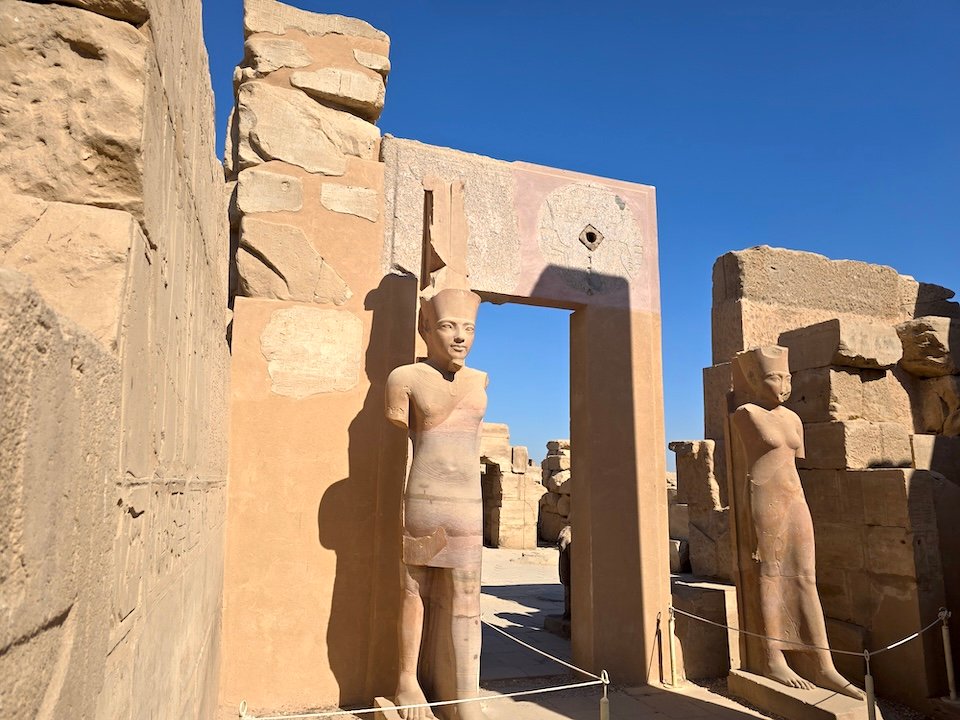Nile Cruise Highlights: A Visit to Karnak Temple
Welcome to Karnak Temple, one of your Nile cruise‘s most significant and impressive stops. This is the biggest religious complex in the world, and it’s more than just a temple. Admire the pharaohs’ magnificence and the tenacity of their faith, which are reflected in every stone of this ancient location.
We start our tour in Luxor by going to the “crown jewel” of Egyptian temples. You will travel through time in the footsteps of the great pharaohs, passing by the sacred lake and the huge obelisks as you meander through the Great Hypostyle Hall, which is shaped like a forest of tall columns. For thousands of years, this location has been the center of Egyptian religion.
When traveling between Luxor and Aswan, a stop at the Karnak Temple is a must. More than thirty pharaohs helped build the world’s largest outdoor museum. This trip is a once-in-a-lifetime opportunity to appreciate the magnificence of Egyptian civilization, as each building, column, and wall here narrates a tale of Egypt’s ancient past.

Old Name and the location of Karnak Temple.
Which was called by the ancient Egyptians the “chosen spot“, the most important ancient temples in Luxor, it is the temple in which the Great god was sanctified, Amun, the Lord of goodness, so the temple reached a great deal of wealth, and his priests became a great political power.
The temple is located in the eastern righteousness of Luxor, and like most of the ancient Egyptian temples was the axis of the temple east- West, and the ancient Egyptian temples were a model of the universe, so the design of the temple reflects the path of the Lord of the sun through the sky, as the temple is unique in the presence of another axis north-south alone than the rest of the temples, facing and was connected another with Luxor Temple by Ram’s avenue, and this road was used in one of the most important celebrations of the ancient Egyptian calendar, which is the Obet Day.
The Story of Karnak Temple.
The ancient Egyptians created the inscriptions that cover the temple walls and sculpted statues that decorate them. Also, there is the largest column hall includes about 134 columns, which are the hall for the most famous and largest hall in the world. The height of these huge columns is 15 meters, except for the twelve middle columns, which is 21 meters high, and the construction of this hall began the third hall “1390-1352 BC” from the eighteenth family, while its decorations return to the era of King Seti I “1294-1279 BC” and Rames II “1279-1213 BC” from the family The nineteenth, and to the proximity of the hall, the wonderful Hatshepsut obelisk “about 1473-148 BC”, which reaches about 30 meter at the height.
Karnak was not a single temple, it a complex of temples, as it includes inside its surrounding walls a complete temple for the God Khonsu in the southern western corner, next to the Obet Temple, which was built in the Greek Roman era, the goddess represented by the shape of the hippopotamus responsible Many temples and other small caners are within the circumference of Karnak, making it a real open museum.

Karnak Temple: Guided by the Best.
There is no city in the world that carries this huge number of temples, such as Luxor. Even the significance of the name is sufficient, as the city that was called this name is due to the many palaces that the Arabs saw in the city. The truth of the architectural heritage is that Luxor is unique among other cities. This city has been established to be the seat of worship and reverence for the ancient Egyptian gods, headed by God, Amun, with his strong and empowered influence.
The Ram’s road that penetrates the city and separates it into about two halves, a witness to the significance of this, as it is the one that links two great edifices in the city. The first is the Karnak Temple, which was devoted to Amon worship, from the first brick in which it was placed until the end of it. With the change of political systems in Egypt throughout those long years. This concept reflects the monuments that were built within the corridors of this temple, starting from the kings of ancient Egypt to the Roman era. However, the greatest focus on this temple and its attention was by the kings of the New Kingdom in ancient Egypt. As they took the god Amon, the god of war, and the donor of victory. Therefore, it was self-evident that attention was given to the creation of the merits, the entertainment, and the edifices of the New Kingdom’s kings within that huge and wealthy facility.
The temple welcomes you with anchorage, which was created on a branching channel from a river. This marina was specially established to transfer the god Amon when he visited the other temple on the edge of the city (Luxor Temple), the temple that was visited by him on the Obet Feast through boats that move it through the Holy Nile River off the temple. Then the ram’s statues stand at the beginning of the temple. It has been with steadfastness for thousands of years in a luxurious way and a great appearance, and the rams are carved with great ingenuity, including statues of the god Amon.
The huge temple consists of multiple and different edifices. The first edifice is the largest and greatest edifice ever, with a height that leads you to an open lobby that includes many of the meals devoted to preserving the sacred journey of Amon on the Obet Day. It is one of the most important ancient Egyptian holidays, which has become a major holiday in the ancient Egyptian state. Specifically, when the 18th dynasty took power. This celebration was held on the occasion of the harvest, the renewal of the state’s authority, and the coronation of the Egyptian king.
After this, the huge Ramses II statue in his Osiris position through the second edifice. Then he entered the doorway of the majestic temple crown. The column hall or the lobby of the great masters, which includes huge numbers of great columns, represents a rich history of Egypt in its previous ages, and the columns are full of patterns and decorations that characterize this temple in particular. Between the inscriptions of the perception of King Seti I kneeling under the holy tree and the god Thoth, the god of wisdom writes his name on it.
And a discussion containing the writing of a poem in the Battle of Kadesh, which is adorned with that hall. This great temple included additions from the kings and emperors of many, numbering 30 properties, all of whom approached the god Amon through reforms and additions that were and still constitute the immortal heritage of Egypt in architecture and arts. At the end of the temple, Hatshepsut’s obelisk stands at its history, which she tried with all her power to feed him in the temples of Amon. Where she was close to him, being the spiritual father of her and her legitimacy in the king, and next to her is also obedient to Tuthmosis, her father, the great victor in his wars, who did not leave the opportunity also to immortalize his memory.
On the side of the temple, the sacred lake is located, a life that is as vibrant as the inscriptions in the temple. The statue of the great wrapping that leads the lake stands as if it is extended with water, and the main nourishment of its life, that lake dates back to the era of King Tuthmosis III, who also added his mark in the corridors of the temple. This lake was used to purify and wash during the ceremonies of religious celebrations in ancient Egypt, where the king and the largest priest were purified in it.
Karnak temple includes a shrine for one of the holy saints in Luxor, who is the son of Eid, one of the Muslim saints; it is on the west side of the Karnak temples.
Trusted Partners
Nile Cruisen: Chosen by Leading Brands as Egypt's Top Cruise Operator











